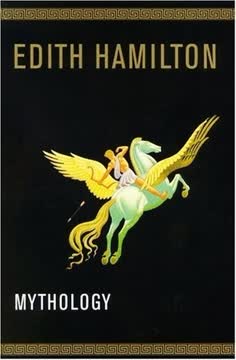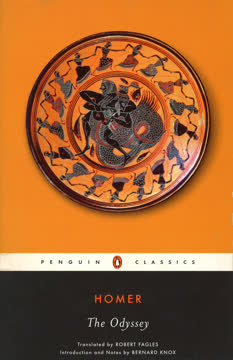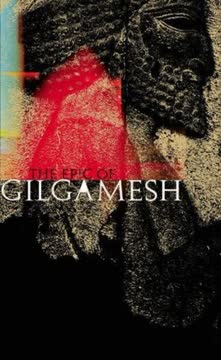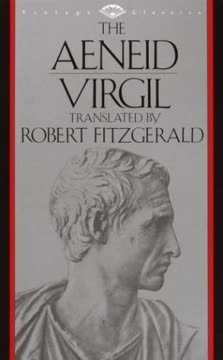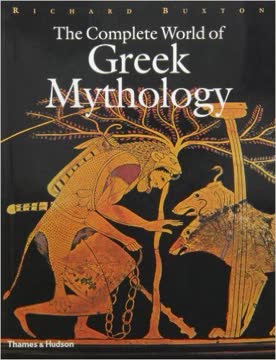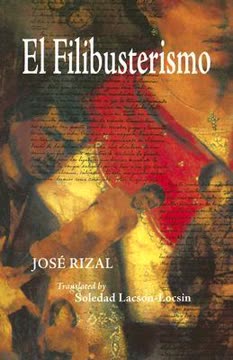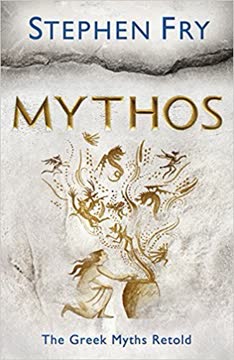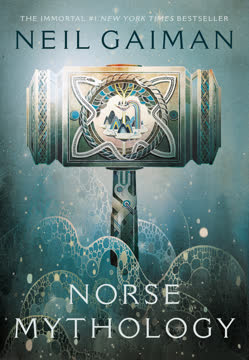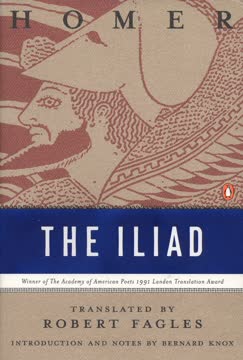Key Takeaways
1. Greek Mythology: A Humanized World Reflecting Human Values
With the coming forward of Greece, mankind became the center of the universe, the most important thing in it.
Human-centric worldview. Unlike earlier mythologies, the Greeks created gods in their own image, imbuing them with human characteristics, emotions, and flaws. This anthropomorphic approach placed humanity at the center of the universe, fostering a sense of rationality and familiarity with the divine.
Rationality and order. The Greek myths, despite their fantastical elements, operate within a framework of reason and logic. Even the most absurd events occur in a world that is essentially matter-of-fact, providing a sense of reassurance and stability.
Beauty over terror. The Greeks transformed a world filled with fear into one brimming with beauty. While the gods could be unpredictable and dangerous, their human-like qualities made them relatable and less terrifying than the monstrous deities of other cultures.
2. Demeter and Dionysus: Earth's Gods of Sorrow and Sustenance
Beside Demeter when the cymbals sound / Enthroned sits Dionysus of the flowing hair.
Gods of the harvest. Demeter, the goddess of corn, and Dionysus, the god of wine, were central to the agricultural cycle and the sustenance of human life. Their worship was deeply intertwined with the daily acts of farming, threshing, and winemaking.
Suffering deities. Unlike the other Olympians, Demeter and Dionysus experienced profound grief and sorrow. Demeter mourned the loss of her daughter Persephone, while Dionysus faced persecution and death. This shared suffering made them relatable to mortals and sources of compassion in times of hardship.
Mysteries and ecstasy. The worship of Demeter and Dionysus involved secret rituals and ecstatic experiences. The Eleusinian Mysteries promised initiates a better afterlife, while the Maenads, followers of Dionysus, engaged in wild dances and revelry in the wilderness.
3. Creation Myths: From Chaos to the Age of Iron
Earth, the beautiful, rose up, / Broad-bosomed, she that is the steadfast base / Of all things.
From chaos to order. The Greek creation myths begin with a formless void called Chaos, from which Night and Erebus emerged. Love then brought forth Light and Day, leading to the creation of Earth and Heaven.
Monstrous offspring. Earth and Heaven gave birth to monstrous creatures like the Titans, Cyclopes, and hundred-handed giants. These beings represented the raw, untamed forces of nature.
The Five Ages of Man:
- Golden: A time of peace and abundance
- Silver: An inferior race lacking intelligence
- Bronze: A race of warriors destroyed by violence
- Heroic: A splendid race of godlike heroes
- Iron: The current age, marked by toil, sorrow, and wickedness
4. Prometheus: The Titan Who Defied the Gods for Humanity
Mankind has flaming fire and therefrom / Learns many crafts.
The benefactor of mankind. Prometheus, a Titan who sided with Zeus against Cronus, is best known for his act of defiance in stealing fire from the gods and giving it to humanity. This gift enabled humans to develop crafts, knowledge, and civilization.
Punishment for defiance. As a result of his actions, Prometheus was chained to a rock in the Caucasus Mountains, where an eagle perpetually devoured his liver. He endured this torment for ages, refusing to reveal a secret that could threaten Zeus's reign.
Symbol of rebellion. Prometheus became a symbol of resistance against tyranny and the pursuit of knowledge, even in the face of divine opposition. His story highlights the tension between human ambition and the power of the gods.
5. Zeus's Love Affairs: A Reflection of Ancient Divine Morality
Father Zeus never helps liars or those who break their oaths.
The philandering Zeus. Zeus, the king of the gods, was notorious for his numerous love affairs with mortal women and goddesses. These liaisons often resulted in the birth of heroes and heroines, but also caused conflict and suffering for Zeus's wife, Hera, and his lovers.
Moral ambiguity. The stories of Zeus's infidelity reflect the complex and often contradictory moral values of ancient Greek society. While Zeus was expected to uphold justice and order, his personal behavior often fell short of these ideals.
The role of Hera. Hera, Zeus's wife and sister, was a powerful and vengeful goddess who relentlessly pursued Zeus's lovers and their offspring. Her actions highlight the themes of jealousy, betrayal, and the consequences of divine actions on mortal lives.
6. The Odyssey: A Hero's Ten-Year Journey Home
Father Zeus never helps liars or those who break their oaths.
A journey of trials. Odysseus, the king of Ithaca, faced numerous challenges and temptations during his ten-year voyage home after the Trojan War. These trials tested his courage, cunning, and loyalty.
Key episodes:
- The Lotus Eaters: A land where eating the lotus flower caused men to forget their homes
- The Cyclops: Odysseus blinded the one-eyed giant Polyphemus
- Circe: A sorceress who turned Odysseus's men into swine
- The Sirens: Enchanting creatures whose songs lured sailors to their deaths
- The Underworld: Odysseus consulted the prophet Teiresias in the land of the dead
Loyalty and perseverance. Odysseus's unwavering determination to return to his wife Penelope and his son Telemachus, despite the many obstacles in his path, is a testament to the power of love and perseverance.
7. The Aeneid: Founding a Nation Through War and Sacrifice
I prate of ancient poets’ monstrous lies, / Ne’er seen or now or then by human eyes.
Aeneas's destiny. Aeneas, a Trojan prince and son of Venus, was destined to found a new Troy in Italy. His journey was fraught with challenges, including storms, battles, and the wrath of Juno.
Key episodes:
- The fall of Troy: Aeneas escaped the burning city with his father and son
- Dido and Carthage: Aeneas fell in love with the Queen of Carthage, but abandoned her to fulfill his destiny
- The Underworld: Aeneas consulted his father Anchises in the land of the dead
- The war in Italy: Aeneas fought against the Latins and Rutulians to establish his kingdom
Roman virtues. The Aeneid celebrates Roman values such as duty, piety, and the importance of fulfilling one's destiny. Aeneas's unwavering commitment to his mission, even at the cost of personal happiness, is a testament to these virtues.
8. The Dark Side of Heroism: Tragedy in the Great Families
In strange ways hard to know gods come to men.
Cursed lineages. Many of the great families in Greek mythology were plagued by curses and tragic fates. These curses often stemmed from the sins of their ancestors and were passed down through generations.
Examples of cursed families:
- The House of Atreus: Marked by betrayal, murder, and cannibalism
- The House of Thebes: Plagued by incest, parricide, and fratricide
Moral complexities. The stories of these families explore the complexities of human nature and the consequences of unchecked ambition, revenge, and hubris. They also raise questions about fate, free will, and the role of the gods in human affairs.
9. The Roman Gods: From Vague Powers to Personified Deities
I prate of ancient poets’ monstrous lies, / Ne’er seen or now or then by human eyes.
Numina and personification. The early Roman gods were vague, impersonal powers known as Numina. As Greek influence grew, these Numina were gradually personified and identified with the Olympian gods.
Lares and Penates. The Lares and Penates were household gods who protected the family and the home. They were venerated in every Roman household and played a central role in daily life.
Practical deities. The Romans valued useful gods who could help with practical matters such as farming, childbirth, and trade. They were less concerned with the beauty and poetry of the Greek gods.
10. Flower Myths: Beauty Born from Tragedy
I heard the footfall of the flower spring…
Transformations. Many Greek myths explain the origins of flowers through the transformation of mortals into plants. These stories often involve themes of love, loss, and the power of the gods.
Examples of flower myths:
- Narcissus: A beautiful youth who fell in love with his own reflection and was transformed into a narcissus flower
- Hyacinth: A young man accidentally killed by Apollo and transformed into a hyacinth flower
- Adonis: A beloved of Aphrodite killed by a boar and transformed into an anemone
Symbolism. The flowers in these myths often symbolize the qualities or emotions associated with the transformed individuals. For example, the narcissus represents vanity, the hyacinth represents sorrow, and the anemone represents fleeting beauty.
Last updated:
FAQ
What is Mythology by Edith Hamilton about?
- Comprehensive myth collection: Mythology by Edith Hamilton is a wide-ranging compilation of Greek, Roman, and Norse myths, drawing from ancient sources to present stories of gods, heroes, and legendary creatures.
- Organization and structure: The book is organized into sections focusing on the gods, creation myths, heroic sagas, love stories, the Trojan War, royal families, lesser-known myths, and Norse mythology.
- Cultural and intellectual insight: Hamilton explores what these myths reveal about ancient civilizations, highlighting the humanized nature of Greek gods and the evolution of religious and philosophical ideas.
- Focus on original sources: The author strives to preserve the voices of original mythologists like Homer and Ovid, presenting myths as close to their ancient forms as possible.
Why should I read Mythology by Edith Hamilton?
- Direct link to classics: The book connects readers to the original perspectives of ancient poets and writers, enriching understanding beyond modern retellings.
- Humanized mythology: Hamilton shows how Greek mythology transformed a fearful world into one filled with beauty and relatable gods, shaping Western thought and art.
- Insight into ancient thought: Readers gain an understanding of ancient worldviews, including ideas about the divine, justice, and human nature.
- Cultural and artistic heritage: The book provides a foundation for appreciating Western literature, art, and philosophy rooted in classical mythology.
What are the key takeaways from Mythology by Edith Hamilton?
- Diversity of myths: The book demonstrates the variety and depth of classical myths, showing their roles as early science, literature, and religion.
- Themes of heroism and fate: It explores recurring themes such as heroism, fate, justice, and the limits of human power.
- Contrast of cultures: Hamilton contrasts Greek optimism and humanism with the somber, fatalistic worldview of Norse mythology.
- Enduring influence: The myths’ stories and characters continue to shape modern culture, literature, and moral thinking.
What is Edith Hamilton’s approach to retelling myths in Mythology?
- Use of classical sources: Hamilton draws from a wide range of ancient authors, including Homer, Euripides, Apollodorus, and Ovid, often choosing the clearest or most representative versions.
- Balanced narrative tone: She combines vivid storytelling with scholarly insight, making complex myths accessible without losing their depth.
- Preservation of original voices: The author avoids imposing her own style, instead aiming to keep the distinct voices of the original mythologists clear to the reader.
- Cultural context: Hamilton provides historical and cultural background, explaining the significance of religious practices, oracles, and societal values.
Who are the main gods and goddesses described in Mythology by Edith Hamilton?
- The Twelve Olympians: The book details Zeus, Hera, Poseidon, Hades, Athena, Apollo, Artemis, Aphrodite, Hermes, Ares, Hephaestus, and Hestia, exploring their personalities, domains, and stories.
- Lesser gods and divine figures: It covers deities like Eros, Hebe, Iris, the Muses, the Graces, and various nature gods, enriching the mythological landscape.
- Roman counterparts: Hamilton explains how Greek gods were adopted by the Romans, often with different names but similar attributes.
- Distinct personalities: Each god or goddess is portrayed with unique traits, relationships, and mythological significance.
How does Mythology by Edith Hamilton explain the creation of the world and mankind?
- Primordial chaos: The book begins with Chaos, from which Night, Erebus, Love, Earth, and Heaven emerge, leading to the birth of the Titans and other primordial beings.
- Titanomachy and rise of Zeus: The Titans are overthrown by Zeus and his siblings, who become rulers of the universe after a great war.
- Creation of mankind: Multiple accounts are presented, including Prometheus and Epimetheus shaping humans, the five ages of man, and the myth of Pandora.
- Flood and renewal: The story of Deucalion and Pyrrha repopulating the earth after a great flood is also included.
What are the most important heroic myths and family sagas in Mythology by Edith Hamilton?
- Greek heroic myths: The book recounts the Twelve Labors of Hercules, the adventures of Perseus, Theseus, and Atalanta, and the saga of the Trojan War.
- Mythological families: It delves into the tragic histories of the House of Atreus (Agamemnon, Orestes) and the Theban family (Oedipus, Antigone), exploring themes of fate, justice, and vengeance.
- Love and adventure tales: Stories like Cupid and Psyche, Orpheus and Eurydice, and the Quest for the Golden Fleece are included, blending romance, heroism, and divine intervention.
- Norse family sagas: The book also covers Norse heroes and gods, such as Odin, Thor, and Sigurd, emphasizing their tragic and heroic struggles.
How does Edith Hamilton portray Hercules in Mythology?
- Complex heroism: Hercules is depicted as immensely strong and courageous but also simple-minded and prone to blunders, making him a deeply human hero.
- Twelve Labors: Each labor is detailed, highlighting the challenges, divine interference, and symbolic meaning behind his feats.
- Tragic suffering: Hercules endures great suffering, including madness and the loss of his family, and seeks redemption through his labors.
- Death and immortality: His death by poisoned robe and subsequent ascension to Olympus illustrate the blend of tragedy and ultimate reward in his story.
What is the significance of the Trojan War in Mythology by Edith Hamilton?
- Origins and causes: The war begins with the Judgment of Paris and the abduction of Helen, setting off a decade-long conflict involving gods and mortals.
- Epic battles and heroes: Key events from the Iliad, such as the quarrel between Achilles and Agamemnon, the death of Hector, and the fall of Troy, are retold with depth and nuance.
- Aftermath and legacy: The book discusses the fates of Troy’s survivors, the Greek heroes’ return, and the enduring impact of the war on later myths.
- Moral complexity: Hamilton highlights the interplay of fate, divine will, and human passion, as well as the moral ambiguities and costs of war.
How does Mythology by Edith Hamilton explain the role of fate and the gods in Greek myths?
- Inevitable fate: Many myths emphasize that fate is unchangeable, even by the gods, as seen in stories like Oedipus.
- Gods’ intervention: The gods frequently interfere in human affairs, often driven by personal motives such as jealousy or favoritism.
- Moral lessons: Myths use divine actions and fate to teach about justice, hubris, and the consequences of human behavior.
- Limits of power: Both gods and humans are shown to have limits, with stories warning against overreach and pride.
What unique perspective does Mythology by Edith Hamilton offer on Norse mythology?
- Somber worldview: Norse myths are presented as a stark contrast to Greek optimism, focusing on inevitable doom and heroic resistance.
- Heroism in defeat: Norse heroes and gods fight bravely despite knowing they will ultimately be destroyed, reflecting a culture that values courage over victory.
- Mythic structure: Hamilton explains the Norse creation myth, the cosmic tree Yggdrasil, and the roles of gods like Odin and Thor.
- Wisdom literature: The book discusses Norse wisdom literature, which offers practical advice and reflects the culture’s philosophical outlook.
How are women and heroines depicted in Mythology by Edith Hamilton?
- Strong female figures: Heroines like Atalanta defy traditional gender roles, excelling in hunting, athletics, and independence.
- Tragic women: Figures such as Clytemnestra and Antigone are portrayed as complex characters who suffer greatly and make pivotal choices about loyalty and justice.
- Goddesses and divine women: Goddesses like Athena, Artemis, and Freya are given distinct personalities and powers, reflecting cultural attitudes toward femininity and divinity.
- Central to mythic themes: Women’s roles are crucial in family sagas, cycles of vengeance, and the unfolding of fate in many myths.
Review Summary
Mythology: Timeless Tales of Gods and Heroes is widely praised as an accessible and comprehensive introduction to Greek and Roman mythology. Readers appreciate Hamilton's clear writing style, thorough sourcing, and engaging retellings of classic myths. While some criticize the brevity of certain stories and limited coverage of non-Greek myths, most find it an invaluable reference. The book is particularly recommended for students and mythology enthusiasts. Many reviewers nostalgically recall encountering it in school and still value it as adults for its educational and entertainment value.
Similar Books
Download PDF
Download EPUB
.epub digital book format is ideal for reading ebooks on phones, tablets, and e-readers.
